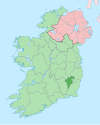Bilboa
This article needs additional citations for verification. (July 2019) |
Bilboa is located on the boundaries of County Laois, Carlow and Kilkenny.[1]
The little settlement at Bilboa was originally based around coal and coal mining.[citation needed] Of the early mining village, only the church remains.[2]52°47′53″N 7°02′24″W / 52.798°N 7.040°W Bilboá's Anglican church[3] is a detached three-bay Tudor Revival Church of Ireland church, built 1846, with crenellated entrance tower and granite dressings including clasping buttresses on octagonal plans having pinnacles and hood mouldings to openings. Interior retains original pews.[4]
The origins of the name Bilboa are reputedly recorded in several small extracts on the organ of the village.[citation needed] The passages were taken from the old school house in the village (now Brennens shop). The general story suggests that a Colonel John Staunton Rochford 1802-1844 returned from fighting in the British army in the Napoleonic wars. He was credited with some act of valour while fighting around the Spanish city of Bilboa.[5] Hence he became known as Rochford of Bilboa, where as his family before him where the Rochfords of Clogrennene. Later members of his family seem to have being involved in some capacity with the building of Bilboa Church 1850. Since then the area has known as Bilboa.
References
- ^ Rootsweb
- ^ "Bilboa - The Mining Village". Rootsweb.ancestry.com. Retrieved 2015-09-09.
- ^ "Main Record - County Carlow: Bilboa Church of Ireland Church, Bilboa, County Carlow". Buildings of Ireland. National Inventory of Architectural Heritage. Retrieved 2015-09-09.
- ^ "Main Record - County Carlow: Bilboa Church of Ireland Church, Bilboa, County Carlow". Buildings of Ireland. National Inventory of Architectural Heritage. Retrieved 2015-09-09.
- ^ "Biolbó/Bilboa". logainm.ie. Retrieved 2015-09-09.

